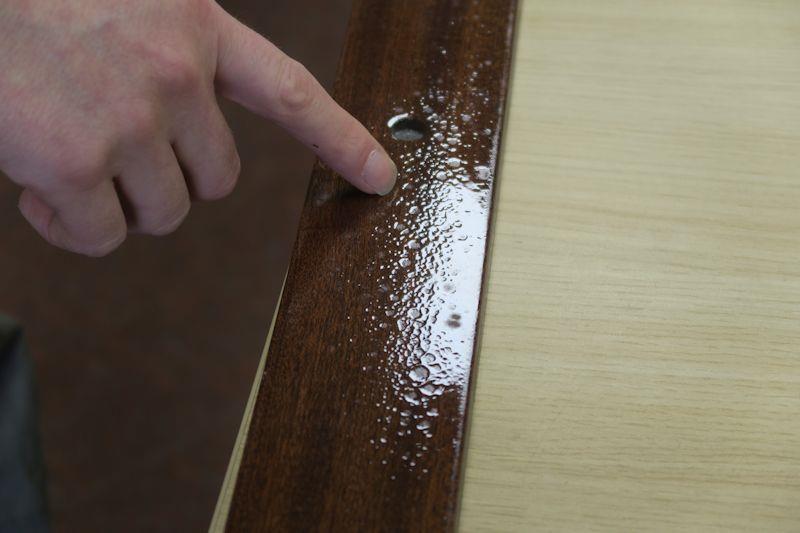
Avoiding the epoxy 'orange peel' effect - advice from Wessex Resins & Adhesives
by Jake Kavanagh 26 Dec 2018 04:00 PST

You've applied a fresh coat of epoxy and the coat seems to have fish-eyed into a series of tiny craters! © WSI
You've applied a fresh coat of epoxy and the coat seems to have fish-eyed into a series of tiny craters. What has caused this and how do you prevent it from happening again?
"The piece of wood in the photo is typical of what can happen when it hasn't been properly prepared for epoxy coating," epoxy expert Hamish says. "This is a piece of mahogany and the customer explained that it had been originally coated with polyurethane varnish. This was removed using paint stripper and the piece was thoroughly abraded back to bare wood. Then a coat of WEST SYSTEM® 105 Resin with 207 Special Coating Hardener was applied. (The 105/207 epoxy mix is used when the wood is to be varnished, as it brings out the full luster of the grain). This orange peel effect was noticed shortly afterwards, so what has happened?
The epoxy has been contaminated. This is because abrading back to bare wood is only part of the preparation process. Despite fresh timber being exposed, it could still contain trapped solvents from the original coating, as well as natural oils. Teak is a naturally oily wood and oak also contains sap-based chemicals that can affect the final surface finish.
The best way to eliminate contamination is to ensure all previous coatings have been completely removed. This can be done with chemical stripping, as seen here, or abrasion. Once the wood is completely bare again then it will need a wash to remove the chemicals used.
WEST SYSTEM 855 Cleaning Solution has been specially formulated for this job and is also very good for removing uncured epoxy from workbenches, or amine blush from cured coatings. If you don't have any 855 to hand, then you can also use clean fresh water but avoid any detergents or soaps, which could actually put contaminants back into the wood. As shown in the picture, both the 855 Cleaning Solution and 850 Cleaning Solvent (for final preparation) are available in A and B pack sizes.
With the wood completely dry, prepare the surface for epoxy coating by abrading again. The grit used should be fine (180 400) as you will need to eradicate any swirl marks from previous coarse sanding, especially if that is how you removed the original coating. A smooth finish will give the best results so hand-sanding with the grain is ideal.
Brush off the dust and then wash the timber again but this time with a solvent. You can use acetone but avoid any spirit-based solvents. Formulations like household White Spirit are packed with oils that will compromise the coating.
WEST SYSTEM 850 Cleaning Solvent is a blend of solvents and will not leave a greasy residue. This has been designed for the best decontamination before overcoating and as it is a blend of solvents the flash-off time has been reduced, so cleaning can be done at a more leisurely pace.
TOP TIP: (This applies to any kind of chemically assisted cleaning.) Don't place the cleaning cloth over the mouth of the solvent container when wetting the cleaning cloth. We've all done it but after a few wipes, dirt and oils on the cloth are washed back into the container to contaminate the solvent. Best practice is to decant a little into a jar and use that instead, ensuring a clean section of cloth is used for each pass.
Don't overlook your brushes and rollers. A common mistake in DIY workshops is to leave these items lying around, perhaps in a jar on the workbench, or in an open pack. Any airborne contaminates from aerosol polishes, WD40, or even airborne cooking oils from a nearby extractor fan, can settle on your rollers and later often much later affect the coating. Keep your brushes and rollers sealed up until you are ready to use them.
The same applies to mixing pots. These are often left stacked upright. Turn them upside down so no dust or airborne contaminants can settle inside. Also, don't trust a pot that has been 'cleaned' unless it was with 855 Cleaning Solution. This is very true of recycled food containers that may have been washed out with detergent or contaminated kitchen cloths. Always use a brand new mixing pot, or one that is scrupulously clean.
It's also a good idea to wear gloves during the preparation process. Although very rare, some hand creams, soaps and even sweat can cause localised problems if absorbed into the virgin timber.
And if you do get orange peel don't despair. Let if cure and then simply abrade it off and start again, this time taking care not to re-contaminate. The end result is worth the effort!
See more tips at: epoxycraft.com/category/blog